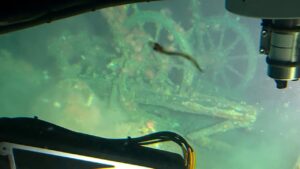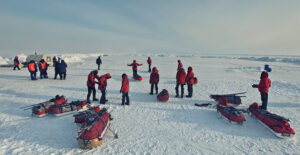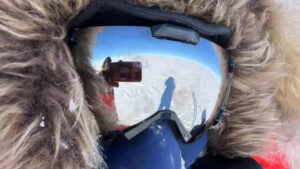The vital question for us was whether or not the ice would open sufficiently to release us, or at least give us a chance of release, before the drift carried us into the most dangerous area.
(Correne Coetzer) Hundred years ago, end of August beginning of September, Ernst Shackleton described the situation on Endurance as “anxious days”, while prisoned in Antarctica’s frozen Weddell Sea.
“In the early morning of September 2 the ship jumped and shook to the accompaniment of cracks and groans, and some of the men who had been in the berths hurried on deck.” u2028u2028The ice did not trouble them again seriously until the end of September, wrote Ernst Shackleton in his book, “South”, though during the whole month the floes were seldom entirely without movement. The roar of pressure would come to them across the otherwise silent ice-fields, and bring with it a threat and a warning.
The routine of work and play on the Endurance proceeded steadily, he said. “Our plans and preparations for any contingency that might arise during the approaching summer had been made, but there seemed always plenty to do in and about our prisoned ship. Runs with the dogs and vigorous games of hockey and football on the rough snow-covered floe kept all hands in good fettle.”
No penguins, no plankton, no land:
By the middle of September the crew was running short of fresh meat for the dogs. “The seals and penguins seemed to have abandoned our neighbourhood altogether. Nearly five months had passed since we killed a seal, and penguins had been seen seldom. Clark, who was using his trawl as often as possible, reported that there was a marked absence of plankton in the sea, and we assumed that the seals and the penguins had gone in search of their accustomed food.”
“The men got an emperor on the 23rd. The dogs, which were having their sledging exercise, became wildly excited when the penguin, which had risen in a crack, was driven ashore, and the best efforts of the drivers failed to save it alive.”
“On the following day Wild, Hurley, Macklin, and McIlroy took their teams to the Stained Berg, about seven miles west of the ship, and on their way back got a female crab-eater, which they killed, skinned, and left to be picked up later. They ascended to the top of the berg, which lay in about lat. 69° 30´ S., long. 51° W., and from an elevation of 110 ft. could see no land. Samples of the discoloured ice from the berg proved to contain dust with black gritty particles or sand-grains.”
“Another seal, a bull Weddell, was secured on the 26th. The return of seal-life was opportune, since we had nearly finished the winter supply of dog-biscuit and wished to be able to feed the dogs on meat. The seals meant a supply of blubber, moreover, to supplement our small remaining stock of coal when the time came to get up steam again. We initiated a daylight-saving system on this day by putting forward the clock one hour.”
Stupendous forces were at work:
While several icebergs passed them during September, during the concluding days the roar of the pressure grew louder and he could see that the area of disturbance was rapidly approaching the ship, Shackleton recalled.
“Stupendous forces were at work and the fields of firm ice around the Endurance were being diminished steadily. September 30 was a bad day. It began well, for we got two penguins and five seals during the morning. Three other seals were seen. But at 3 p.m. cracks that had opened during the night alongside the ship commenced to work in a lateral direction. The ship sustained terrific pressure on the port side forward, the heaviest shocks being under the forerigging. It was the worst squeeze we had experienced.”
All hands to stand by in readiness for whatever emergency might arise. Even the dogs seemed to feel the tense anxiety of the moment.
Shackleton quoted Worsley: “The behaviour of our ship in the ice has been magnificent. Since we have been beset, her staunchness and endurance have been almost past belief again and again. She has been nipped with a million-ton pressure and risen nobly, falling clear of the water out on the ice. She has been thrown to and fro like a shuttlecock a dozen times. She has been strained, her beams arched upwards, by the fearful pressure; her very sides opened and closed again as she was actually bent and curved along her length, groaning like a living thing. It will be sad if such a brave little craft should be finally crushed in the remorseless, slowly strangling grip of the Weddell pack after ten months of the bravest and most gallant fight ever put up by a ship.”
The vital question – but no answer from the silent bergs:
The Endurance deserved all that could be said in praise of her, Shackleton stated. “Shipwrights had never done sounder or better work; but how long could she continue the fight under such conditions? We were drifting into the congested area of the western Weddell Sea, the worst portion of the worst sea in the world, where the pack, forced on irresistibly by wind and current, impinges on the western shore and is driven up in huge corrugated ridges and chaotic fields of pressure.”
“The vital question for us was whether or not the ice would open sufficiently to release us, or at least give us a chance of release, before the drift carried us into the most dangerous area. There was no answer to be got from the silent bergs and the grinding floes, and we faced the month of October with anxious hearts.”
Background:
On August 8, 1914, Ernest Shackleton and his crew set off from Plymouth, England, on the Endurance for the 1914-17 Imperial Trans-Antarctica Expedition. This became one of the most heroic, endurance and leadership adventure stories in history.
The Endurance, the ship which will take the Trans-continental party to the Weddell Sea, and will afterwards explore along an unknown coast-line, is a new vessel, specially constructed for Polar work under the supervision of a committee of Polar explorers. She was built by Christensen, the famous Norwegian constructor of sealing vessels, at Sandefjord. She is barquentine rigged, and has triple-expansion engines giving her a speed under steam of nine to ten knots. To enable her to stay longer at sea, she will carry oil fuel as well as coal. She is of about 350 tons, and built of selected pine, oak, and greenheart. This fine vessel, equipped, has cost the Expedition £14,000.
#polar #shackleton #endurance #southpole #antarctica
Previous: Endurance 100 years ago: anxious days (August 1915)






